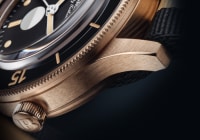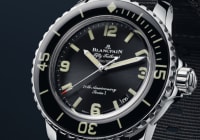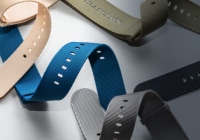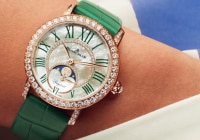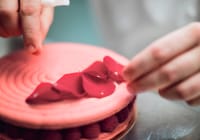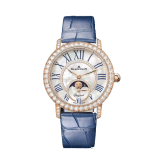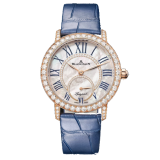
Search in Issues
Chapters
List of parts
Chapter 8
Ladybird Colors
The newest models of the Ladybird collection arrive in vibrant colors.
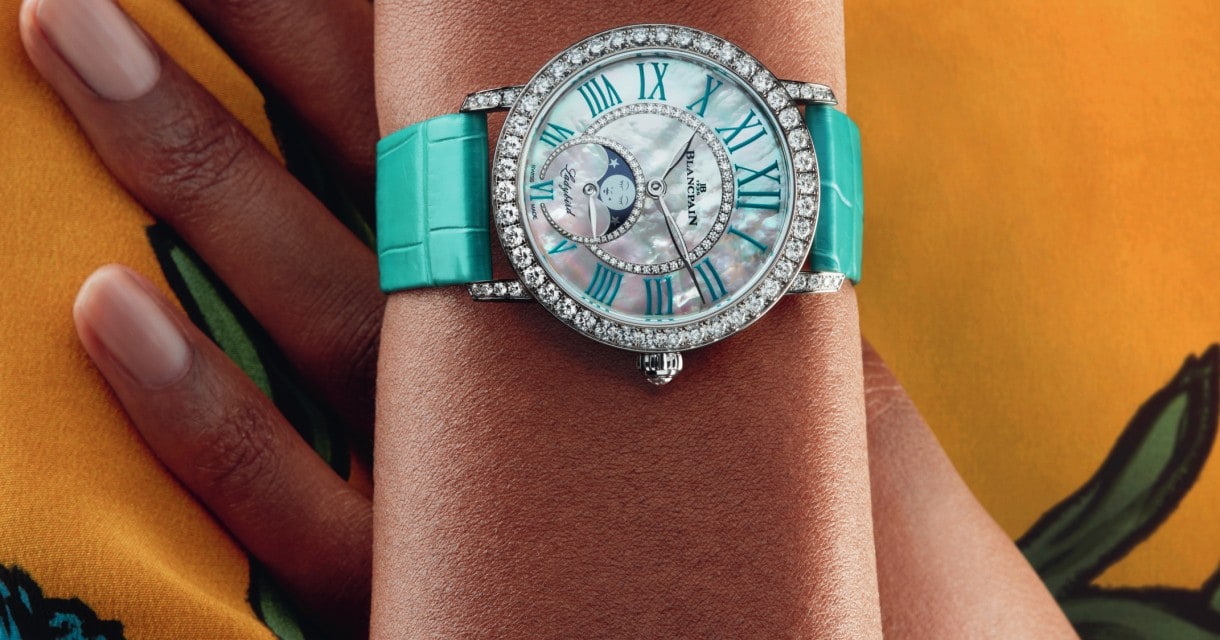
A WOMAN’S WATCH DESIGNED BY A WOMAN, EMBRACED BY PASSION
Feminine timepieces have been a pillar of Blancpain for nearly a century. Blancpain named its original women’s watches the “Ladybird”. In this era, Blancpain’s CEO was a woman named Betty Fiechter, the first woman to lead a substantial Swiss watch house. The Ladybird she created became legendary as a woman’s watch designed by a woman. Among its many triumphs and responding to the then fashion demands for petite women’s watches, the Ladybird established a world record for having the smallest round movement ever produced. Marilyn Monroe’s most precious timepiece was an elegant diamond-encrusted Blancpain. Such was Blancpain’s savoir-faire in the production of small movements for women’s watches that many watch brands throughout Switzerland came to rely upon Blancpain movements for their timepieces.
The refined tastes of the modern woman have inspired the designs of today’s Ladybird collection. Blancpain recognizes that the exceptional finely finished mechanical movements, including complications, that define the Ladybird are prized by discriminating women. So too are artistic embellishments, such as fine stone setting, mother-of-pearl dials, and colorful, easily changeable straps.
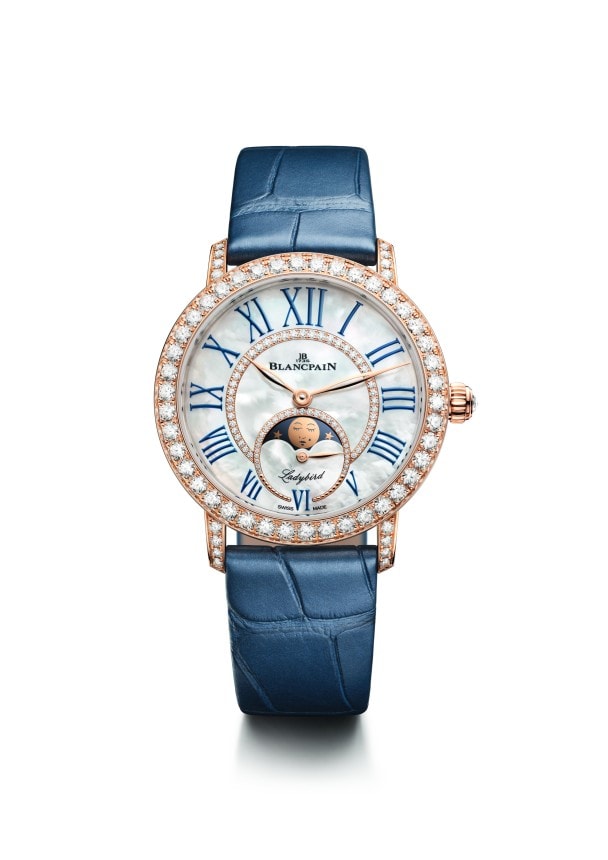
What’s in a name? Is it meant to recall grand chapters from the past? Special individual timepieces that were significant historical achievements? Or something else? By bringing the newest women’s timepieces together with the pre-existing women’s models under the umbrella of the name “Ladybird”, Blancpain is signaling all of the above: chapters from the past, significant timepieces, and more.
The original Ladybird was born in 1956 when Blancpain was co-led by Betty Fiechter and her nephew Jean-Jacques Fiechter. The fashion of the time prized small watches for women. To understand the magnitude of their achievement in the development of the original Ladybird with its extraordinarily small movement, keep in mind that the conception of any fine watch movement presents a host of design and watchmaking challenges. Reducing the size to a minimum increases the difficulty exponentially. Betty and her nephew were even more ambitious, as they set out not only to make the diameter of the original Ladybird seductively small, they sought to make it the smallest in the world. They met the challenge that they set for themselves by creating the smallest-diameter round movement in the world. Going beyond that watchmaking first, they incorporated innovations that ensured robustness. Normally, it is a watchmaking axiom that minimizing the dimensions of a mechanical movement brings with it fragility. Indeed, at the time, a competitor’s small rectangular women’s movement was notorious for its delicacy and penchant for breakage. The vintage Blancpain Ladybird upended this usual paradigm by adding an extra wheel to the movement’s gear train that endowed it with both a world-record small size and reliability.
The creation of the Ladybird was a springboard that elevated Blancpain into prominence in the world of feminine timepieces. Indeed, its production of small women’s watch movements placed it in the top ranks in Switzerland. Notably as well, movie star Marilyn Monroe’s watch was a diamond-encrusted Blancpain.
As important as these achievements were, the Ladybird represented something more. It embodied the drive, determination, vision, or better said, grit, of Betty Fiechter. She rose to take the reins of Blancpain following the death of her mentor Frédéric-Emile Blancpain. Frédéric-Emile was the last Blancpain family member to lead the enterprise, a succession that had remained in the family without interruption through seven generations of Blancpains following its founding in 1735. Betty had become a trusted assistant, rising from her apprenticeship which began in 1915, eventually taking her to the key posts as head of manufacturing, technical and commercial development. Such was Frédéric-Emile’s trust in her that he moved to Lausanne in his last years, leaving Betty on site to manage the business in Villeret, the village where Blancpain was founded and in which all of its facilities were found.
When Frédéric-Emile passed away in 1932, Betty joined with her head of sales, André Léal, to purchase Blancpain.
There is a touching letter marking the transfer of Blancpain after 200 years within the founding family to Betty Fiechter. Frédéric-Emile’s daughter, Nellie, wrote to Betty:
“My dear Betty:
You can imagine that it is not without a painful wrenching of my heart that I see the conclusion for me of the period that links me to all the memories of my childhood and youth. The end of Villeret for Papa brings real sadness, but I can assure you that the only solution which can truly ease my sadness is your taking over of the manufacture together with Mr. Léal. Thanks to this fortunate solution, I can see that the traditions of our precious past will be followed and respected in every way. You were for Papa a rare and dear collaborator. One more time let me thank you for your great and lasting tenderness, which I embrace and carry with me in my heart.
Best to you, Nellie”
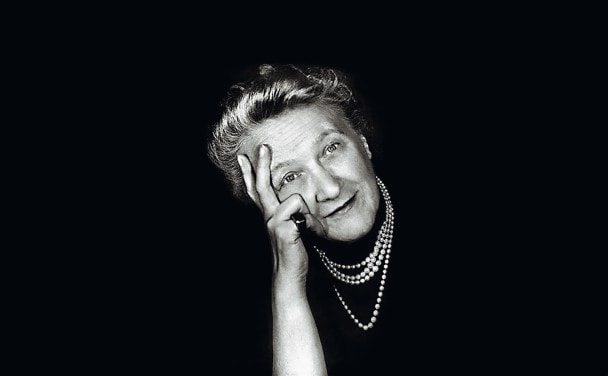
Betty Fiechter, who led Blancpain for nearly four decades and created the original Ladybird.
There was an additional dimension to her ascension at Blancpain, as she became the first woman owner/CEO of a significant Swiss watch company. To put that accomplishment into perspective, at that time in Switzerland, not only were women rarely found in business circles, they were not even allowed to vote in many cantons.
Her pioneering spirit taking on leadership was to be frequently tested by challenges that would almost certainly have defeated a less capable, less strong executive. Immediately, she had to overcome two massive blows. First, her right to continue using the company name “Blancpain” was taken away owing to a peculiarity of then Swiss law. A business that utilized a family name would be prohibited from continuing with the name if family members were no longer affiliated with the enterprise. So it was that she was forced to change the corporate name “Blancpain” to “Rayville”, a name derived from the village name Villeret where Blancpain was located. Fortunately, this legal prohibition would be subsequently reversed, allowing her to reinstate the historical name. Losing the name was shortly thereafter succeeded by further misfortune, when her principal business partner André Léal perished while on a sales trip.

Marilyn Monroe and her diamond-set Blancpain.
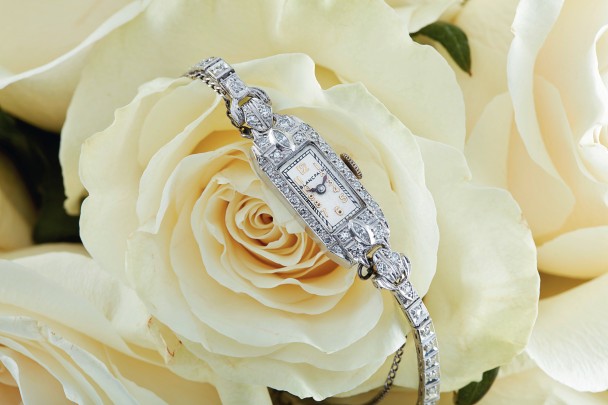
The CREATION of the new Ladybird Colors SPANNED FOUR YEARS.
Business perils continued with the arrivals of the Great Depression followed by World War II. This period, from the Depression through the end of the war, saw massive numbers of business failures throughout Switzerland, the watch industry being particularly hard hit. One metric starkly testifies to the difficulties that confronted the Swiss watch sector. In Blancpain’s native village of Villeret, there once had been 200 different watch houses. That number evaporated over time leaving only three, Blancpain being the largest. Yet Betty persevered, guiding Blancpain through all of these dangers that proved fatal to less courageous and less talented business leaders. There were two key strategies that underpinned Blancpain’s survival. The first was the development of women’s watches. Of course, as Blancpain aficionados know, the second pillar was the creation of the Fifty Fathoms. It was from the first pillar that the Ladybird was born.
In many ways, her triumph in the creation of the Ladybird made that timepiece a symbol not only of watchmaking prowess and savoir-faire, but of feminine fortitude, confidence, and strength of character. Betty Fiechter’s legacy is what inspires Blancpain today in the women’s collection, and lies behind the grouping of all of those watches together under the name Ladybird. So it is that the spirit of the vintage Ladybirds and Marilyn Monroe’s Blancpain lives on in the newest models, reinterpreted to reflect modern tastes.
The creation of the newest Ladybird, called Ladybird Colors, spanned four full years at Blancpain. At the outset, there was one clear objective. Many of the watches in the existing collections are worn by both men and women. Good examples are Bathyscaphes and Air Commands offered in smaller diameters. Like the original Ladybird, a timepiece designed by a woman for women, the new model was to be decidedly feminine. A woman’s timepiece. The designers pored over every detail. The first decision was size. The fashion of the 1950s, which prized watches of the smallest diameter possible, has been replaced by today’s favored larger and more versatile sizes. But what should that larger size be? Multiple factors come into play. The way in which the lugs are fashioned plays a significant role in how the watch forms to the wrist. Expressed in the vernacular: does the watch “wear large” or “wear small”? By subtly curving the lugs downward, Blancpain ensured that the new case would fit well on a wide range of women’s wrists. Then came the balance among three factors: the actual diameter, the size of the dial relative to the diameter, and the thickness of the case. Harmonizing all of these, working with 3D-printed trials of different dimensions, led to a diameter of 34.9 mm and a dial of 28mm.
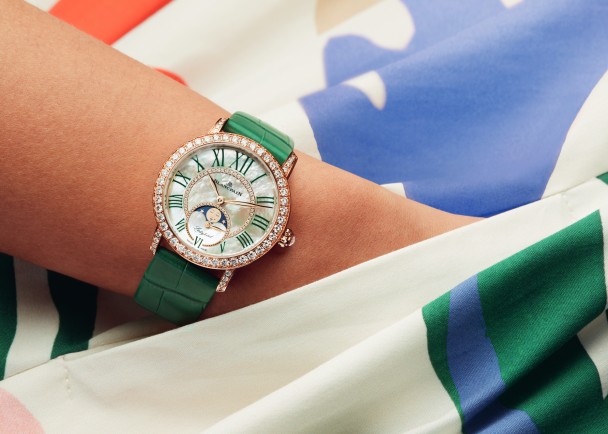
The forest-green Ladybird Colors in red gold with moon phase.
The Ladybird Colors DIAL is realized in an ultra-exclusive variety of EXTRA WHITE MOTHER-OF-PEARL.
The dial itself accounted for years of trials. The key to the design was the decentering of key elements: the indexes, and two rings of diamonds. Decentering brings a unique visual interest and allure. The largest elements were located at the top of the dial, gradually diminishing in size toward the bottom. Capturing the same geometry were the two diamond-set rings, the smaller encircling and forming a subdial at 6 o’clock, joined by the larger circle. Detailed touches abound. The two diamond circles echo the graduated indexes: larger stones at the top flowing into smaller stones toward the bottom of the dial. One goal was clear: the smaller circle forming a subdial would allow for two versions. One with a classic small-seconds indication, the other with a moon phase and small seconds paired together.
Lying behind the visual allure of the dial are the towering savoir-faire and craftsmanship brought to bear in its creation. It all starts with an exceptional variety of mother-of-pearl that is the stage for the diamond-set rings and indexes. The dial’s intriguing pale white luminescence and subtle undulations are only found within a staggeringly rare selection of shells. The shimmering white color can only be obtained in shells of the highest grade, termed “extra white”. The refined texture goes beyond the already lofty extra white category to the even more exclusive variety known internally as “bulles de savon” (“soap bubbles”). Found on a miniscule percentage of extra white shells, and even then only on a small portion of a shell, the “soap bubble” sections bring enhanced visual depth to the dial from their subtle wave forms. To illustrate the degree of rarity of this combination of criteria—extra white and soap bubbles—an entire shipping container of farmed shells is required to find a very small number of shell sections that can be used for Blancpain’s dials. There is no waste, as the remainder of the farm-raised shells are purposed for less selective use.
When cut from the mother-of-pearl shell, the resulting disks are breathtakingly thin. Indeed, so much so that they are semitransparent. In order to be used for the dial, the disks are first painted with a white varnish on the back side so as to ensure a white luster to the front side and, thereafter, glued to a disk made of German silver. The several steps that follow include the fastening on the back side of the German silver disk of tiny feet used to attach the dial to the movement, the drilling of the holes for the hands, the milling of the track for the ring-shaped diamond inserts on the dial (more on those in a moment), and, on the moon-phase models, the milling of the aperture for the moon-phase display.
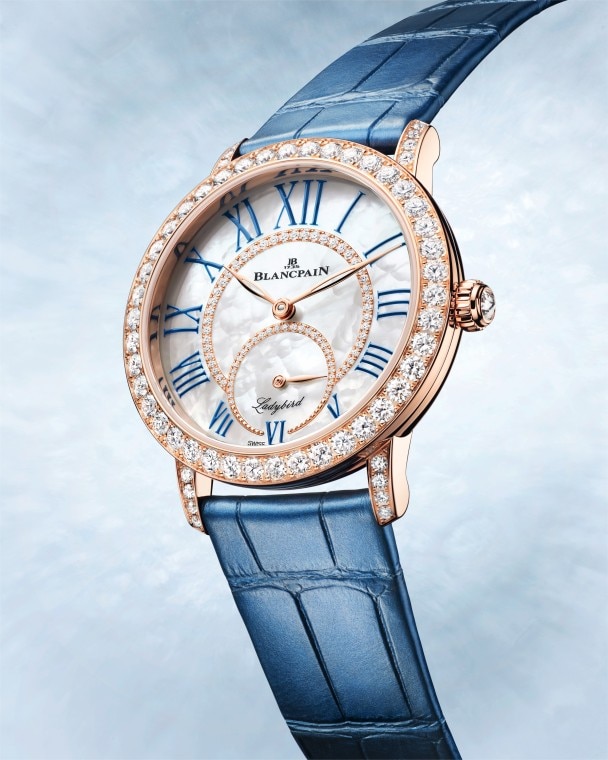
The midnight-blue Ladybird Colors in red gold.
To bring EXTRA VISUAL DEPTH, the dial indexes are printed with FIVE SEPARATE COATS of color.
The next sequence is the printing of the indexes. For a standard dial, printing is done once. To bring extra depth to the Ladybird Colors’ dial, the indexes are printed five times. The process demands extraordinary skill, as the dial maker has to form a judgment on the length of time between each successive application of ink from the preceding application. At all costs, the ink from the previous application must be sufficiently dry before another layer can be added. Room temperature and humidity are taken into account by the skill of the dial maker. Things become more complex with the Colors version, as the process for each color takes place separately.

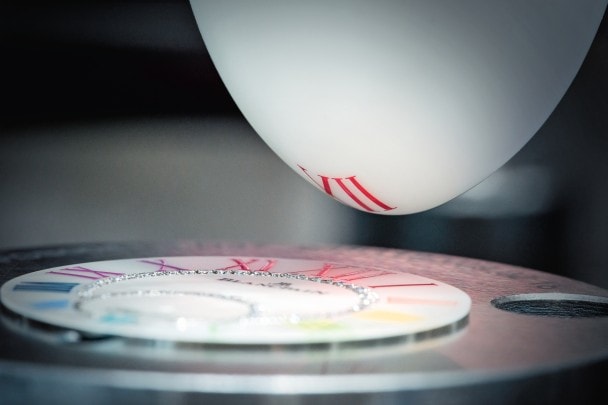
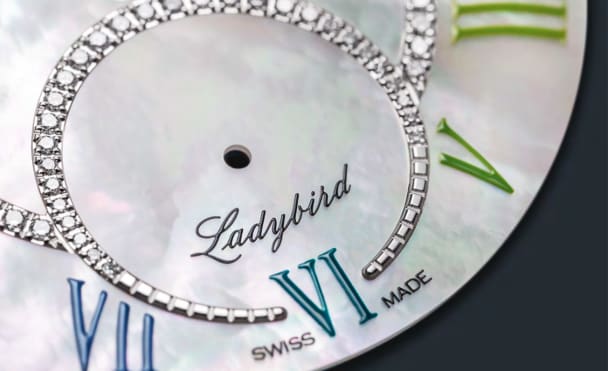
Each COLOR of the COLORS dial is applied separately from the others.
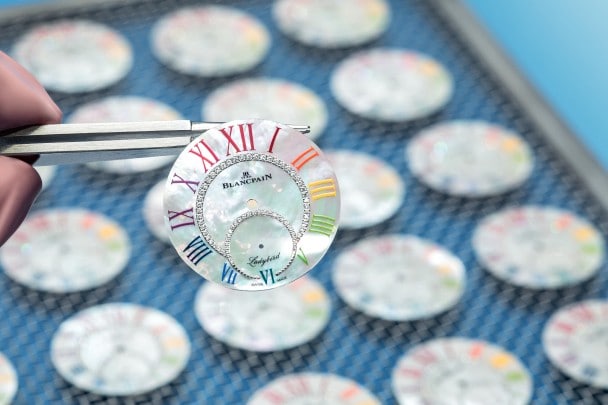
The CREATION of the dial’s connected diamond-set rings is ITSELF AN ART FORM.
The creation of the inner connected diamond-set rings is itself an art form. It begins with the milling of the rings from a square tile of gold. For the red-gold Ladybird Colors models, the rings are formed in 4N rose gold (4N is slightly less red in color than the case, which is made in 5N); for the white-gold models, the rings are in the same shade of white gold as the case. Starting from the tile of gold, five comprehensive steps are involved before arriving at a cut ring that includes the small wells with tiny “grains” for later insertion of the diamonds. The setting of the stones, entirely done by hand, is complex, as the width of the rings is widest at the 12 o’clock position, tapering down toward 6 o’clock. Eleven different sizes of diamonds are thus required to match the taper of the shape.
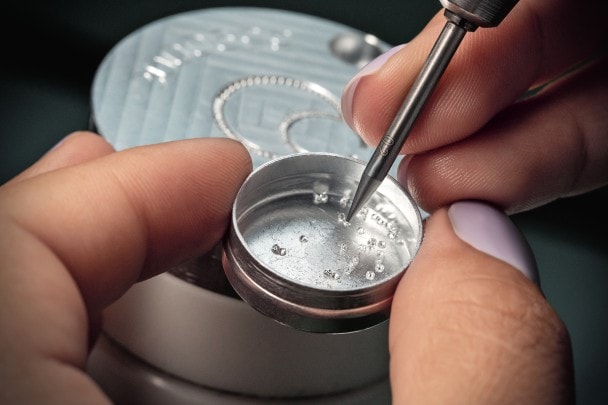
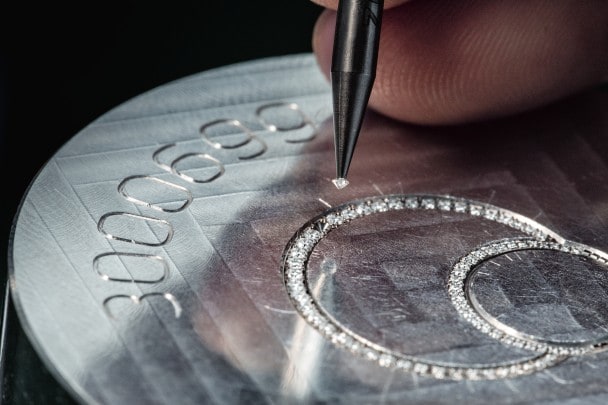
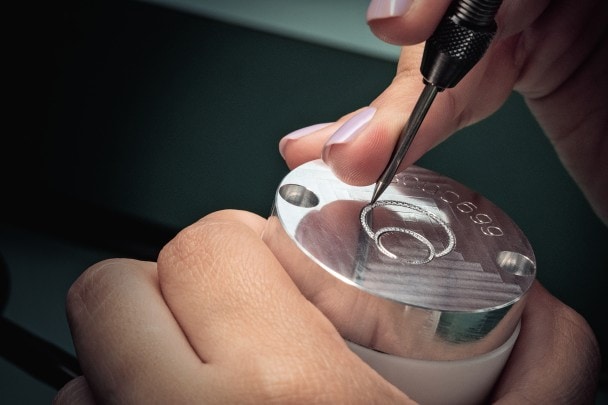
There are ELEVEN DIFFERENT SIZED STONES THAT ARE SET BY HAND, each stone precisely oriented to follow the curve of the ring.
For each gem location, the stone setter selects the properly sized stone, one by one, with a tool known as a “poussoir” that holds the stone with a tiny drop of oil. Thereupon, the setter must not only place the diamond into its position, but orient the facets so that they follow the curve of the ring. Once properly positioned, four tiny gold “grains” are hand-pressed against the stone securing it in place. Hand-polishing, followed by cleaning, are the last steps in the crafting of the rings, which are then ready to be inserted into the mother-of-pearl dial.
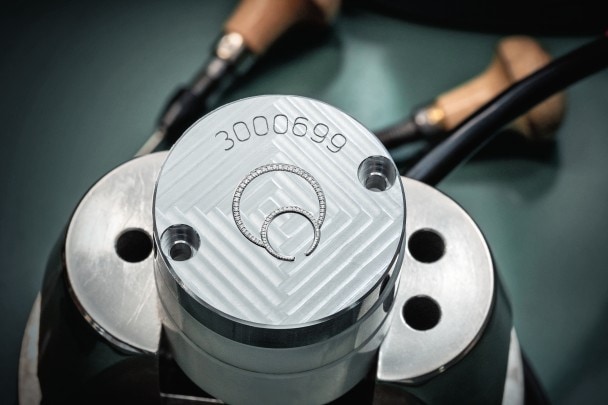

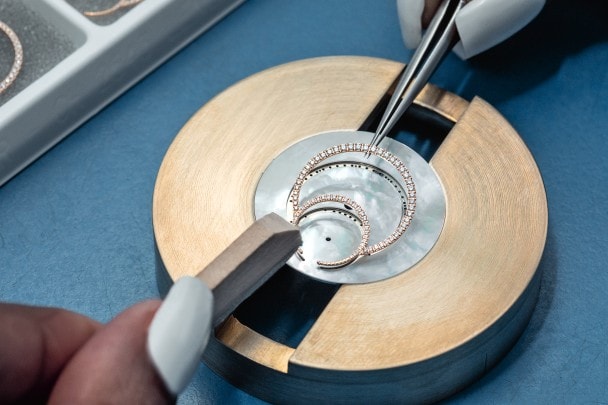
FRESHNESS IN THE COLORS is a key element of the design.
Freshness in the colors became a key element in the design. For all but one of the new Ladybird Colors, the color of the indexes is keyed to the color of the strap, with a range of five different possibilities: midnight blue, peacock green, forest green, lilac, and turquoise. The one exception is the Colors model, which features indexes in a rainbow of hues. That opens up the door for five differently colored straps that will be supplied with the watch. To enable easy changing to suit the woman’s mood, each strap is fitted with a spring bar that includes a tab hidden underneath. Pulling on the tab makes quick work of removal and installation of a different color. The same system is fitted into the diamond-encrusted gold buckle. It too can be readily moved from one strap to another. With the strap/buckle changing system facilitating swapping among the five straps, the color palette can match whichever colored index suits the occasion.
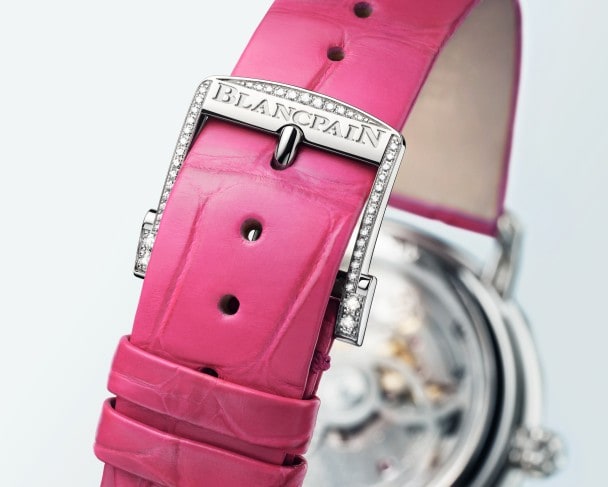
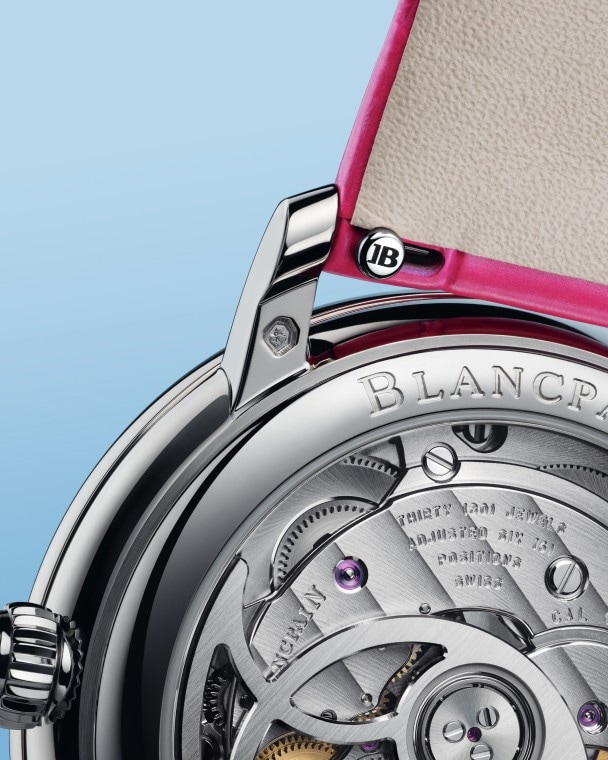
Changing of the strap made easy with tabs on both the strap and the buckle.
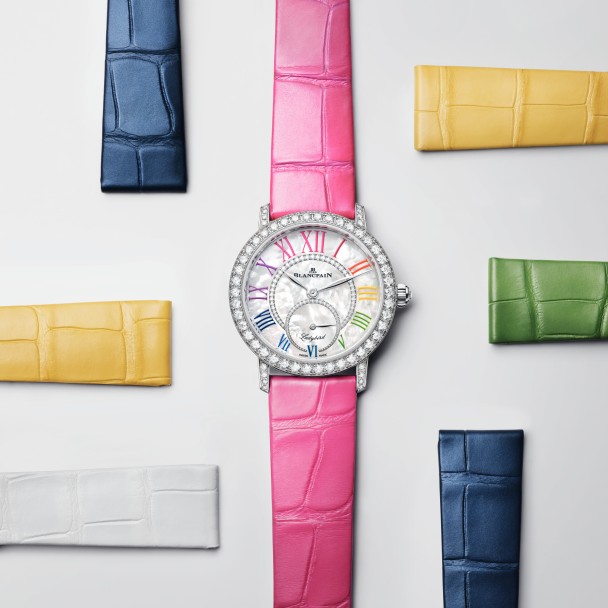
The movement of the Ladybird Colors SETS ITSELF APART from movements found elsewhere in feminine timepieces with its TWO MAINSPRING BARRELS and 100-HOUR power reserve.
The new Ladybird Colors is powered by Blancpain’s in-house 1150 caliber. The 1150 sets itself apart from the movements found elsewhere in feminine timepieces with its two mainspring barrels (the practice elsewhere is a single barrel), which allows the timepiece to achieve a 100-hour power reserve. Thus, the owner can place her Blancpain in a drawer for more than a weekend and find it still running and ready for wear without resetting. The automatic winding rotor, fashioned in 22-carat gold, has been sculpted into an arcing form that captures the spirit of the dial. The finely finished movement with its contrasting rotor are opened up for view through the sapphire crystal case back.
Today’s new Ladybird Colors bring Betty Fiechter’s legacy to life in a fresh, modern way.
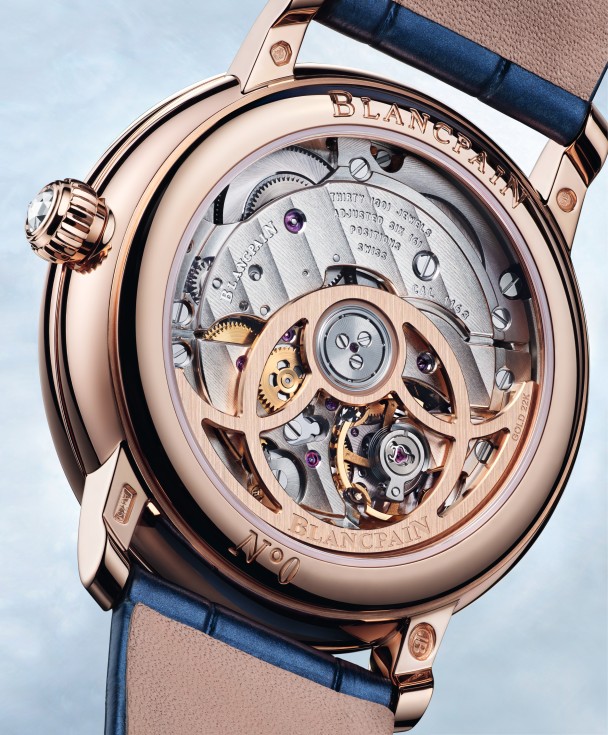

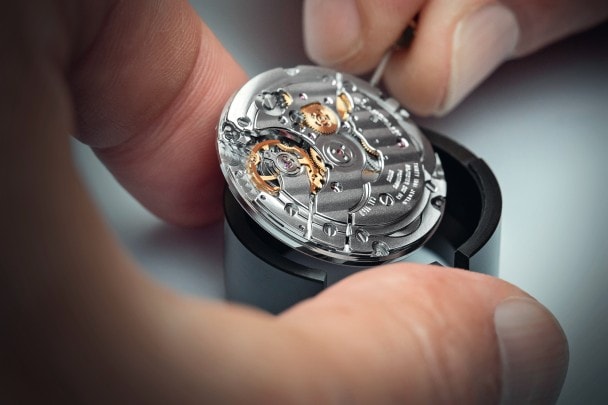
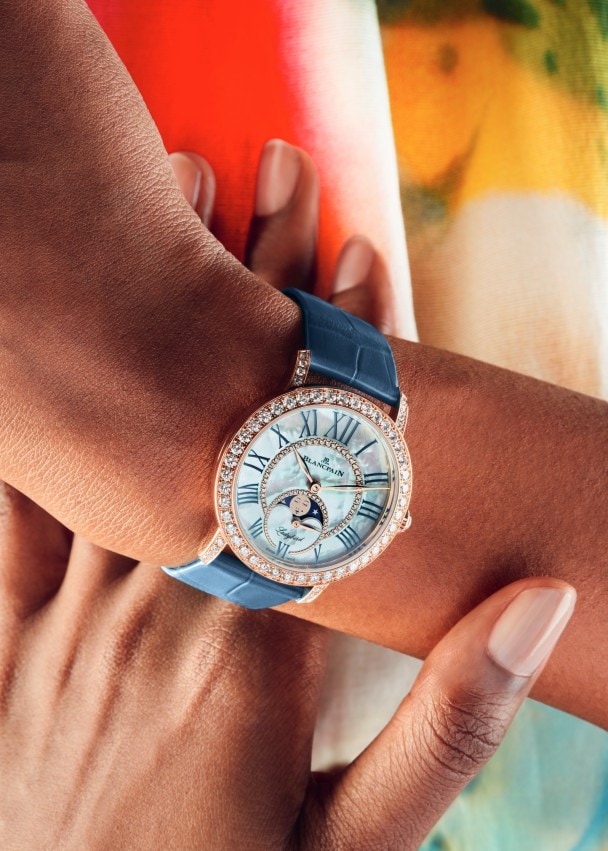
Other issues
Don't miss the latest issue
Sign Up for New Releases


